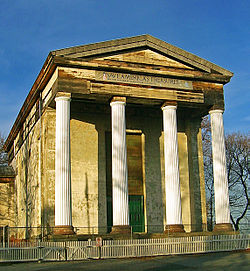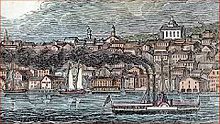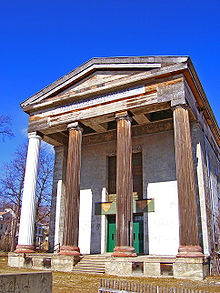- Dutch Reformed Church (Newburgh, New York)
-
Dutch Reformed Church
 The church in late 2006, with all four columns restored
The church in late 2006, with all four columns restoredLocation: 132 Grand St.
Newburgh, NYCoordinates: 41°30′16.03″N 74°0′32.34″W / 41.5044528°N 74.0089833°WCoordinates: 41°30′16.03″N 74°0′32.34″W / 41.5044528°N 74.0089833°W Built: 1835 Architect: Alexander Jackson Davis Architectural style: Greek Revival Governing body: City of Newburgh Part of: Montgomery-Grand-Liberty Streets Historic District (#73001246) NRHP Reference#: 70000425 Significant dates Added to NRHP: December 18, 1970[1] Designated NHL: August 7, 2001[2] The Dutch Reformed Church is one of the most prominent architectural landmarks in Newburgh, New York. It was designed by Alexander Jackson Davis in 1835 in the Greek Revival style common in America in that time period. It is his only surviving church in that style and is considered to be his latest building still standing that largely reflects his original vision.[3] It is located at 132 Grand Street, just north of the Newburgh Free Library.
Its historical importance comes from not just over a century of use as church, but its centrality in the struggle by modern preservationists to save and restore the city's many landmark buildings. Today it is a National Historic Landmark. It was almost razed in the late 1960s, and even today is far from completely restored.
Contents
Description and site
The church is 50 feet (15 m) wide and high, and 100 feet (30.5 m) long. The four front Ionic order columns are 37 feet (12 m) high (the capitals have been removed for safety considerations at the moment). It sits on a bluff 250 feet (76 m) above the Hudson River, a few blocks away.[4] In the 1830s there were no other buildings in the vicinity to impede the view, so Davis saw it as symbolizing the city to the considerable river traffic of the time.
The edifice occupies a commanding situation... Owing to the immediate and rapid descent of the ground east of the site, the basement line of the portico is above the top of the buildings between it and the river; so that the full effect of its architecture may be seen while passing the town...[5]The southward orientation of the columns and facade, the direction in which most shipping approached the city, was meant to echo the similar marine outreach of the Parthenon or the Temple of Poseidon at Sounion in Greece.[5]
The original design included a small dome atop the roof, which Davis explained thus:
The gigantic portico, and lofty dome…will henceforth serve as a conspicuous and characteristic landmark, indicative of the taste, discrimination, and sense of classical beauty, of the inhabitants of Newburgh.[6]It was removed a few years after the building was completed for structural reasons. Other additions were built on to the property by the church as its growth warranted.
While the church had the neighborhood of Grand Avenue and Third Street to itself at the time of its construction, today it has become rather crowded. It is now a contributing property of the Montgomery-Grand-Liberty Streets Historic District, which includes other notable historic buildings such as the former Orange County Courthouse, another Greek Revival building (designed by locally prominent architect Thornton Niven) across the street, the library, several other large old churches (some still in use).
Several blocks to the south, along Liberty Street, is another site of major historical interest — the Hasbrouck House, today preserved as Washington's Headquarters State Historic Site owing to its use for that purpose during the last years of the Revolutionary War. To the north the area becomes more residential but still includes some of the city's older and larger homes, although some have been allowed to deteriorate in the last several decades.
The current siting both enhances and complicate its aesthetic position. On the former hand, most of the buildings around it are of similar historic value. On the latter, the brutalist library that sits cater corner from it is not only a serious contrast in styles, it blocks most of the view the river and the church once had of each other. The church, library and dilapidated former Metropolitan Club of Newburgh form a small plaza; however part of it is taken up by a small parking lot built by the Newburgh Enlarged City School District, which runs the library and is headquartered in it, for its own central office employees.
History
The building's history can be divided into two eras: its actual use as a church from 1835 to 1967, and the attempts to preserve and refurbish it since then.
Church era
In 1834 the Rev. William Cruickshank was sent upriver from New York City by Dutch Reformed Church elders to start a new church.[6] He commissioned Davis for the design and the cornerstone was laid the following year.[6]
It was completed and dedicated two years later. But by 1839, the church had to mortgage the building to pay construction costs, and the dome and its lantern were removed in 1843.[6]
The mortgage payments did not prevent the church from expanding the property, with a small parsonage being erected on the southeast corner in 1852, where the library now stands. Seven years later, the mortgage was paid off. The church put the money it could now spend more freely to work on the structure, adding a pastor's study and recessed pulpit and repainting the interior (not completely enough; some of the original stenciled Greek motifs are still visible today).[6]
After the Civil War, the congregation had reached 290 members. It was able to add 20 feet (6 m) onto the north side of the building, complete with transepts designed by George Harney, and purchase an organ. By 1882, it had grown to 400 members and paid off all its outstanding debt. The church would get a new roof two years later, followed a decade after that by a replacement organ and pulpit.[6]
The first years of the 20th century saw it get some electric lights, and another new roof. In 1909 an iron fence was built with money paid to the church by the city for the use of its lawn during the previous year's Fulton-Hudson celebration. The following year cement replaced wood as the flooring material for the portico, and in 1920 all lighting in the building became electric when the chandeliers switched from gas.[6]
For the first time in its history, the church would finally take a stable form. No major work beyond routine repair was done until after World War II, when various storms damaged the roof. However, in 1950 a hurricane blew the roof completely off. While the church was able to repair it and in fact make further improvements such as adding telephone service and a public address system, the years had taken their toll and in 1964 the congregation had acquired land in the Town of Newburgh on which to build a new edifice. Three years later, they deconsecrated Davis's building and moved out.[6]
Preservation era
World Monuments Fund video on conservation of the Dutch Reformed Church in 2009 World Monuments Fund video on conservation of the Dutch Reformed Church in 2010
World Monuments Fund video on conservation of the Dutch Reformed Church in 2010
It was soon slated for demolition as part of the city's urban renewal efforts. Helen Gearn, the city's historian at the time, urged that it be preserved and somehow reused. After a feasibility study concluded it could be done, the "Palatine Square" proposal for the blocks in the immediate vicinity included the church.[7]
Nevertheless, the next year the city claimed the church as an urban-renewal parcel, and the next year its Urban Renewal Agency paid $96,000 for it.[7] Public efforts against its demolition led to the church's addition to the National Register of Historic Places in 1970, which meant that federal funds could no longer be used to demolish it. Newburgh had in the past taken the lead in historic preservation when Washington's Headquarters had become the first officially-designated historic site in the U.S. in 1850. The battle to save the church revived this tradition and marked the beginning of the city's modern historic preservation movement.
Orange County expressed interest in buying the building as part of the "Courthouse Square" project, a proposal to redevelop the area around the courthouse just across the street, which served as Ulster County's when Newburgh was that county's seat prior to the redrawing of county boundaries that followed the creation of Rockland County in 1798.[7] At the time, the county was still using the courthouse as a branch of the main county courts in Goshen. The Hudson Valley Philharmonic also looked into making the church its home.
The state's Office of Historic Preservation designated a historic district in nearby downtown areas of the city, but it did not include the church. The Greater Newburgh Arts Council continued working to save the church.[7]
While the building was safe for the time being, its exterior, particularly the columns, were in an advanced state of decay. The federal Department of Housing and Urban Development which administered the city's urban-renewal grants, ordered in 1974 that it be either razed or sold. The city bought it for $7,000.[7]
Three years later the Hudson Valley Freedom Theater (HVFT) bought the building, hoping to make it a playhouse. The purchase was conditioned on the theater company being able to renovate the structure within a certain time. The National Park Service repaired the roof. In 1984 the theater company defaulted on its contract and title reverted to the city. The following year the state expanded the city's historic district to include the church, while the NPS removed the column's Ionic capitals.[7]
The 1990s saw the beginning of piecemeal efforts to restore the church. Another city historian, Kevin Barrett, called for the building's preservation in 1994, and the Council on the Arts intensified its efforts.[7] It was suggested that the city or private donors restore one of the original columns, as a way of demonstrating that the restoration of the whole church, though a considerable task, was not impossible.
Hillary Rodham Clinton, then First Lady, spoke in front of the church before a large crowd on July 14, 1998 as part of the Save America's Treasures tour.[7] The $128,205 federal grant received as part of that program paid to stabilize the church's upper gallery, which was then in imminent danger of collapse.[8]
The 21st century began with two events that signaled the struggle over the church was not now for its preservation but its restoration. The Dutch Reformed Church Restoration Committee was formed by local activist Carla Decker, former president of the Historical Society of Newburgh Bay and the Hudson Highlands, in 2000 and the next year became part of the Newburgh Preservation Association. On August 7, 2001, the church was designated a National Historic Landmark by the Department of the Interior after a successful application by state preservation official William Krattinger.[2],[9]
A state grant made possible the repair and restoration of the church's drainage system and west foundation wall.[10] The picket fence was repainted in 2004, and the following year the World Monuments Fund put the church on its list of the 100 Most Endangered Sites.[11]
Future projects
Today, efforts to restore the church to its original glory continue. The DRCRC is actively involved in raising money for those efforts and promoting the church's historical importance. In 2002 the NPA commissioned the Albany firm Mesick Cohen Wilson Baker to do a Historic Structure Report summarizing what needed to be done to restore the building.
One column and window were restored in 2004,[12] the first time since the church's deconsecration that any work had been done on the building's decorative elements. In 2006, the remaining three columns were restored through a combination of in-kind repayment and donated services.
Still, much work needs to be done. Estimates for implementing all the suggestions of the Historic Structure Report and completely restoring the church have ranged as high as $8 million.[13] After restoration, ideas for what to do with the church have centered around cultural activities, consistent with similar such secondary uses in the past.[14] In 2006 the Newburgh Preservation Association, with a grant from the Dyson Foundation, commissioned an Adaptive Re-Use Study to outline potential uses.
References
- ^ "National Register Information System". National Register of Historic Places. National Park Service. 2007-01-23. http://nrhp.focus.nps.gov/natreg/docs/All_Data.html.
- ^ a b "Dutch Reformed Church (Newburgh)". National Historic Landmark summary listing. National Park Service. http://tps.cr.nps.gov/nhl/detail.cfm?ResourceId=998494994&ResourceType=Building. Retrieved 2007-09-11.
- ^ Aldrich, J. Winthrop; April 10, 2003; Foreword to Historic Structure Report; retrieved November 8, 2006 from newburghdrc.org.
- ^ October 17, 1835; "A Description of the Dutch Reformed Church Now Erecting in the Village of Newburgh"; Newburgh Gazette; as cited in Krattinger, William; April 10, 2003; History of the Dutch Reformed Church, retrieved from newburghdrc.org November 8, 2006.
- ^ a b Dutch Reformed Church Restoration Committee; undated; Setting; newburghdrc.org; retrieved November 5, 2006.
- ^ a b c d e f g h Dutch Reformed Church Restoration Committee; undated; Early History; newburghdrc.org; retrieved November 5, 2006.
- ^ a b c d e f g h Dutch Reformed Church Restoration Committee; undated ; Later History; newburghdrc.org; retrieved November 6, 2006.
- ^ Save America's Treasures; June 1999; Project Profile:Dutch Reformed Church; saveamericastreasures.org; retrieved November 6, 2006.
- ^ William E. Krattinger (February 15, 2001). National Historic Landmark Nomination: Dutch Reformed Church, NewburghPDF (765 KB). National Park Service and Accompanying 6 photos, exterior and interior, from 2000.PDF (1.84 MB)
- ^ Dutch Reformed Church Restoration Committee; undated; Foundation Work '03; newburghdrc.org; retrieved November 6, 2006.
- ^ World Monuments Fund; World Monuments Watch: 100 Most Endangered Sites 2006, retrieved November 6, 2006.
- ^ Dutch Reformed Church Restoration Committee; January 9, 2005; First Column Restoration; newburghdrc.org; retrieved November 6, 2006.
- ^ Belden, Maureen; February 2002; Savior at Last: A Newburgh Group Has Big Plans to Restore a Landmark Church; Hudson Valley; retrieved from newburghdrc.org November 7, 2006.
- ^ Dutch Reformed Church Restoration Committee; Adaptive Re-Use; newburghdrc.org; retrieved November 7, 2006.
External links
- 16 photos, interior and exterior, from 1967 and 1970, at HABS
- Dutch Reformed Church Restoration Committee
U.S. National Register of Historic Places Topics Lists by states Alabama • Alaska • Arizona • Arkansas • California • Colorado • Connecticut • Delaware • Florida • Georgia • Hawaii • Idaho • Illinois • Indiana • Iowa • Kansas • Kentucky • Louisiana • Maine • Maryland • Massachusetts • Michigan • Minnesota • Mississippi • Missouri • Montana • Nebraska • Nevada • New Hampshire • New Jersey • New Mexico • New York • North Carolina • North Dakota • Ohio • Oklahoma • Oregon • Pennsylvania • Rhode Island • South Carolina • South Dakota • Tennessee • Texas • Utah • Vermont • Virginia • Washington • West Virginia • Wisconsin • WyomingLists by territories Lists by associated states Other  Category:National Register of Historic Places •
Category:National Register of Historic Places •  Portal:National Register of Historic PlacesCategories:
Portal:National Register of Historic PlacesCategories:- Historic district contributing properties
- Closed churches in New York
- National Historic Landmarks in New York
- National Register of Historic Places in Orange County, New York
- Greek Revival architecture in New York
- Buildings and structures completed in 1835
- 19th-century Reformed Church in America church buildings
- Newburgh, New York
- Reformed Church in America churches
- Former Dutch Reformed churches in New York
- Properties of religious function on the National Register of Historic Places in New York
- Religious organizations established in 1834
- Calvinist organizations established in the 19th century
- Protestant congregations established in the 19th century
- Individually listed contributing properties to historic districts on the National Register
- Churches in Orange County, New York
Wikimedia Foundation. 2010.



